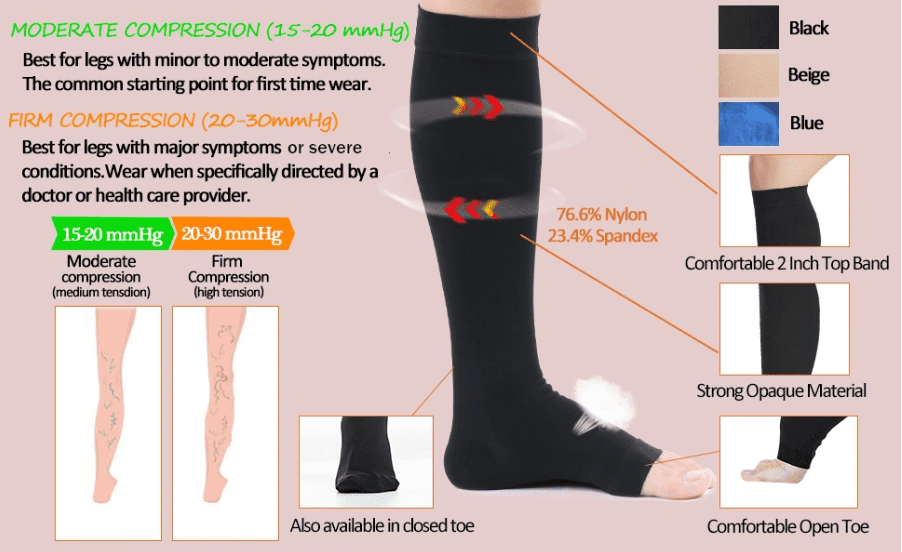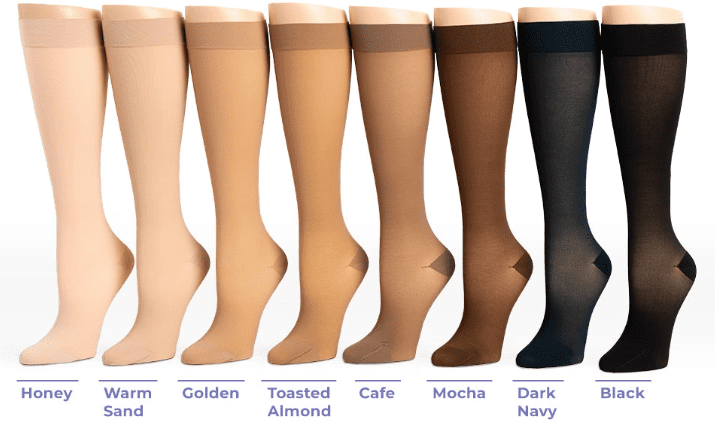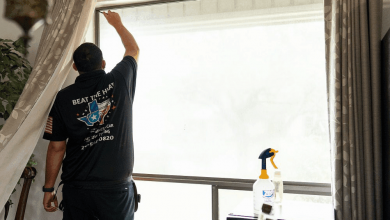Open Toe vs Closed Toe Stockings: What Doctors Don't Tell You

The design of compression stockings’ toes substantially affects both comfort and therapeutic benefits. Studies show these stockings boost blood flow in lower legs by almost a quarter and cut leg inflammation by nearly two-thirds. Medical consultations rarely explain the choice between open and closed toe options in detail.
Patients often need to research the differences in open toe compression stockings by themselves. Most healthcare providers recommend closed toe stockings as the standard option. These stockings work better because they put steady pressure on the whole foot. This helps prevent and improve swelling and varicose veins. Open toe stockings have their own advantages in specific cases. This piece breaks down the differences between these options and explains which type works best in different situations. You’ll also learn the right way to put on open toe compression stockings to get the best results. Understanding these differences becomes crucial if you’re looking at toeless designs.
What’s the Real Difference Between Open Toe and Closed Toe Stockings?
The difference between open toe and closed toe compression stockings goes beyond just toe coverage. These designs provide graduated compression that lessens pressure from ankle to thigh. The toe area design creates unique wearing experiences that might lead to different therapeutic results.
How compression works in both types
Open toe and closed toe stockings employ the same basic principle of graduated compression. The therapeutic pressure reaches its peak at the ankle (typically 15-30 mmHg) and slowly decreases up the leg. This pressure gradient helps blood flow upward against gravity and improves its return to the heart.
The biggest difference shows up in how pressure spreads across the forefoot. Closed toe stockings keep steady compression throughout the foot, including the toes. Open toe designs leave the toes free, which creates a pressure-free zone at the front of the foot.
Both styles use the same compression technology—elastic fibers woven into the fabric create the needed pressure gradient. They also come with reinforced heels that last longer and fit properly.
Toe coverage and its effect on comfort
The way toes are covered affects how comfortable these stockings feel. Open toe styles work better for many people, especially those who have:
- Toes that get irritated easily
- Wider toe spreads
- Feet that sweat a lot
- Nail problems that need air
Open toe designs don’t have toe seams, which means fewer pressure points and less irritation. This helps diabetic patients or people with peripheral neuropathy by reducing friction on sensitive toes.
Some people like the snug feel of closed toe designs better, particularly in cold weather. Full foot coverage feels more secure and keeps toes from feeling exposed.
Does toe design affect medical benefits?
Research shows little difference in main therapeutic benefits between these designs. Both types boost circulation in the lower extremities and reduce swelling when they fit right.
Getting the right fit matters more than toe design. Poorly fitting stockings can create pressure points that might restrict circulation instead of helping it. Stockings that squeeze toes too tightly can cause discomfort and might limit blood flow.
Certain conditions benefit from specific toe designs. People with fungal infections or diabetic foot problems often do better with open toe designs. These keep the toe area dry and easy to treat. Patients recovering from toe surgery usually find open toe designs more comfortable.
The choice comes down to balancing medical needs with comfort priorities. Many doctors suggest trying both styles. This helps find what works best for each patient. A compression stocking only helps if someone wears it regularly.
When Open Toe Stockings Make More Sense
Both toe designs help therapeutically, but open toe compression stockings work better in specific situations. The weather and foot conditions play a big role in choosing stockings with exposed toes. These choices can substantially improve comfort and make people more likely to wear them regularly.
Hot weather and breathability
Summer heat challenges compression stocking wearers. Open toe designs let your feet breathe better than closed ones. Your toes stay exposed, which lets air move freely and cools your entire foot.
Most compression stocking makers suggest open toe options during summer. These designs help regulate temperature while providing the right therapeutic pressure. The cooling isn’t just about comfort – it helps people stick to wearing their stockings through hot weather.
Quality summer compression stockings combine mild to moderate pressure (15–20 or 18–22 mmHg) with materials that pull moisture away from your skin. Your feet won’t sweat as much as they might in closed toe designs. This breathability makes summer much easier if you need to wear compression stockings all year for medical reasons.
Foot conditions like bunions or athlete’s foot
Open toe compression stockings are perfect if you have certain foot issues:
- Bunions (Hallux Valgus): The toe area stays pressure-free, so nothing rubs against painful bunions. Special bunion relief socks with split-toe designs reduce friction between your big toe and second toe even more.
- Athlete’s Foot: Exposed toes mean drier feet, which helps prevent fungal growth. This design helps people who often get infections from too much moisture.
- Toe Spreading: People with naturally wide-set toes find open designs more comfortable since their toes move freely.
The toe-free design removes pressure points, which helps sensitive feet. Diabetic patients or people with peripheral neuropathy benefit from these stockings since they don’t put pressure on sensitive toes.
Wearing sandals or flip-flops
Open toe compression stockings let you wear summer shoes easily. They work great with sandals, flip-flops, and peep-toe shoes.
These stockings stay hidden, unlike closed toe ones that might bunch up or stick out of open-toed shoes. You can show off painted toenails too – something many people care about.
Many brands know this matters and make open toe options just for sandal wearers. This solves a common problem: keeping up with compression therapy while dressing right for warm weather.
Using with toe socks or stockings toeless
Open toe designs give you options if you want some toe coverage while getting compression therapy. You can add separate toe socks or covers to match your comfort needs. This gives you compression benefits plus custom toe coverage.
Stockings toeless designs offer another choice. These compression leggings leave your whole foot free. They work great if you want barefoot comfort but need pressure on your legs.
Daily wearers love mixing different foot coverings with compression therapy. You don’t have to choose between compression and comfort – you can adjust your therapy based on what you’re doing and what feels right.
Why Closed Toe Stockings Are Still the Default
Healthcare providers still recommend closed toe compression stockings over open toe options, even as open toe styles gain popularity. This preference comes from several practical benefits that help users in many ways.
Full foot support and warmth
Closed toe compression stockings cover your entire foot and create even pressure distribution. This detailed support helps reduce swelling more effectively throughout the foot. The snug fit reaches all the way to your toes, which keeps the stockings in place during daily activities and feels comfortable to wear.
The full coverage design keeps your feet warm in cold weather. Many patients choose closed toe designs because they want extra warmth when it gets cold. This becomes crucial if you have circulation issues that already make your feet feel cold.
The pressure these stockings apply across your whole foot helps prevent and improve swelling and varicose veins. Users love them because they get both therapeutic benefits and comfort in one garment.
Better fit for shoes and boots
Closed toe designs work great with everyday footwear. These stockings combine smoothly with closed shoes, boots, and athletic footwear. Your feet won’t experience bunching or slipping inside shoes because of the complete foot coverage.
Many closed toe models last longer thanks to reinforced heel and toe areas. JOBST Opaque compression stockings have “reinforced foot zones” that handle daily shoe wear better. The reinforced structure makes these stockings last much longer.
You won’t need extra socks over your compression garments when wearing regular shoes. This simple benefit makes closed toe stockings the top choice for many people who wear them daily.
More style and material options
Closed toe compression stockings give you more choices in styles, materials, and colors than open toe options. While open toe styles often look medical, closed toe designs come in many fashionable variations.
Mediven Elegance closed toe stockings blend “medical efficacy with unique wearing, comfort and style” and offer colors like black, navy, caramel, beige, sienna, and sand. You can even request special colors such as anthracite, magenta, light blue, russet red, lilac, and sage green.
New material technologies make wearing closed toe stockings more pleasant. Some models feature moisture-wicking and antimicrobial treatments, like the “Clima-Comfort technology and Clima-Fresh system”. Others use “Nilit Aquarius fibers” that provide “effective moisture wicking so that legs feel comfortable all day long”.
You can find options that match your wardrobe and lifestyle while getting the therapeutic benefits you need, thanks to this wide selection.
Medical professionals tend to focus on clinical benefits when they prescribe compression hosiery. They often overlook several vital aspects that affect patient experience and compliance.
How toe fit can affect circulation
The way stockings fit around the toes directly affects blood flow through the foot. Closed toe stockings that don’t fit right can create a tourniquet-like effect at the toe box. This might block the circulation they want to improve. The problem happens more with pre-manufactured sizes that don’t match each person’s foot shape.
The role of personal comfort in long-term use
Patient compliance is the key to successful compression therapy. Healthcare providers often don’t realize how much toe design affects daily wear. Studies show that approximately 30% of patients stop using their prescribed compression therapy because it feels uncomfortable. The right open toe design can make the difference between patients sticking to their therapy or giving up.
Why open toe may be better post-surgery
Open toe stockings have clear advantages after foot or toe surgeries that surgeons rarely mention. They let you:
- Check wounds without removing the stocking
- Fit bandages and dressings easily
- Put less pressure on sensitive surgical sites
Compression strength vs. toe design
Practitioners focus on compression grade (mmHg) but often miss how toe design changes pressure distribution. The toe part of stockings can change how pressure feels by a lot, even when open and closed designs have similar compression ratings. This difference matters more for patients with peripheral neuropathy or diabetes.
Yes, it is more important to find the right balance between therapeutic pressure and how well it fits the foot’s shape than to stick with traditional closed toe designs.
How to Choose the Right Type for You
The perfect compression stockings balance your medical needs with personal factors. Your daily routine, foot anatomy, and the way you put them on are vital parts of finding the right match.
Assessing your lifestyle and daily activities
Your typical day matters a lot before you pick a stocking toe design. To cite an instance, see sandal wearers or people in hot climates – open toe compression stockings give them ventilation and style flexibility. Office workers who wear closed shoes all day might do better with full-coverage options. Closed toe designs blend better with formal footwear.
Considering foot shape and toe spread
Your foot’s anatomy makes a big difference in comfort. People with naturally wide toe spreads often feel uncomfortable in closed toe designs. Those with bunions, hammertoes, or arthritic joints usually find open toe stockings more comfortable. If you have fungal nail infections or need regular podiatry visits, open toe styles work best. They allow better air circulation and easier access.
How to put on open toe compression stockings properly
The right way to get the best fit:
- Turn the stocking inside-out up to the heel
- Place your foot in the provided “easy-on” slipper
- Position your heel correctly within the stocking
- Pull the stocking smoothly over your ankle and up your leg
- Remove the slipper through the open toe area
- Make sure the heel sits properly without wrinkles
Sizing tips for both types
The right measurements give you the proper fit. Take measurements early in the morning when swelling is minimal. Both designs need ankle circumference (just above the bone), calf circumference (at widest point), and length measurements. Note that foot size matters less with open toe designs. This makes them perfect for people whose foot measurements don’t match standard sizing charts.
Conclusion
Your unique needs and priorities determine the choice between open toe and closed toe compression stockings. Both designs provide graduated compression benefits, but they serve different purposes. Open toe designs work best in hot weather and are ideal for foot conditions like bunions or athlete’s feet. They also work great with sandals. Closed toe options give full foot support and blend naturally with regular shoes. They come in more style choices too.
The choice goes beyond just medical needs. Patient comfort plays a vital role in sticking to the treatment. Many patients stop using prescribed compression therapy because it feels uncomfortable. Finding the right design that feels good becomes key to successful treatment. Your foot shape, daily routine, and even the weather should guide your choice.
The right application techniques ensure you get the most benefit from either design. Getting the right measurements and putting them on correctly helps with comfort and results. The compression strength varies with different toe configurations, which changes how the pressure feels.
While closed toe designs remain the standard choice, open toe options have their own advantages. The right compression stocking strikes a balance between medical needs and personal comfort. Even the most effective stocking won’t help if it’s too uncomfortable to wear regularly. These details help patients make better choices about their compression therapy instead of just following standard advice.
FAQs
1. What’s the main difference between open toe and closed toe compression stockings?
Open toe stockings leave the toes exposed, while closed toe stockings cover the entire foot. Open toe designs offer better ventilation and are more suitable for warm weather, while closed toe stockings provide full foot support and warmth.
2. When should I choose open toe compression stockings?
Open toe stockings are ideal for hot weather, wearing sandals or open-toe shoes, and for people with certain foot conditions like bunions or athlete’s feet. They also work well for those who need better breathability or have wider toe spreads.
3. Are closed toe compression stockings more effective medically?
Both open and closed toe designs provide similar medical benefits when properly fitted. The key difference lies in comfort and personal preference. Closed toe stockings may offer more consistent pressure across the entire foot, but open toe designs can be better for specific foot conditions.
4. How do I properly put on open toe compression stockings?
Turn the stocking inside-out up to the heel, use the provided “easy-on” slipper, position your heel correctly, pull the stocking up smoothly, remove the slipper through the open toe area, and ensure there are no wrinkles, especially at the heel.
5. Can wearing the wrong type of compression stocking affect circulation?
Yes, improperly fitted stockings, especially closed toe designs that are too tight, can create a tourniquet-like effect at the toe box, potentially hindering circulation. It’s crucial to choose the right size and style for your foot anatomy and comfort to ensure optimal therapeutic benefits.

Source: Open Toe vs Closed Toe Stockings: What Doctors Don't Tell You





